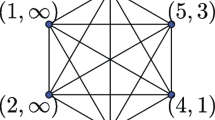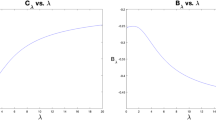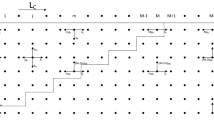Abstract
The car parking problem is a one-dimensional model of random packing. Cars arrive to park on a block of length x, sequentially. Each car has, independently, spin up or spin down, w.p. 0 < p ≤ 1, for spin up and q = 1 − p for spin down, respectively. Each car tries to park at a uniformly distributed random point t ∈ [0, x]. If t is within distance 1 of the location of a previously parked car of the same spin, or within distance a of the location of a previously parked car of the opposite spin, then the new car leaves without parking and the next car arrives, until saturation. We study the problem analytically as well as numerically. The expected number of up spins c(p, a) per unit length for sufficiently large x is neither monotonic in p for fixed a, nor is it monotone in a for fixed p, in general. An intuitive explanation is given for this nonmonotonicity.
Similar content being viewed by others
REFERENCES
J. D. Bernal, A geometrical approach to the structure of liquids, Nature 183:141-147 (1959).
E. R. Cohen and H. Reiss, Kinetics of reactant isolation. I. One-dimensional problems, J. Chem. Phys. 38:680-691 (1963).
A. Dvoretzky and H. Robbins, On the parking problem, Publ. Math. Inst. Hungar. Acad. Sci. 9:209-225 (1962).
J. W. Evans, Random and cooperative sequential adsorption, Rev. Mod. Phys. 65:1281-1329 (1993).
D. Freedman and L. Shepp, An unfriendly seating arrangement, SIAM Review 4:150-150 (1962).
P. J. Flory, Intramolecular reaction between neighboring substituents of vinyl polymers, J. Am. Chem. Soc. 61:1518-1521 (1939).
P. C. Hemmer, The random parking problem, J. Stat. Phys. 57:865-869 (1989).
Y. Itoh, On the minimum of gaps generated by one-dimensional random packing, J. Appl. Prob. 17:134-144 (1980).
P. L. Krapivsky, Kinetics of random sequential parking on a line, J. Stat. Phys. 69:135-150 (1992).
P. E. Ney, A random interval filling problem, Ann. Math. Statist. 33:702-718 (1962).
A. Renyi, On a one-dimensional problem concerning space-filling, Publ. Math. Inst. Hungar. Acad. Sci. 3:109-127 (1958).
M. Tanemura and M. Hasegawa, Geometrical models of territory I. Models for synchronous and asynchronous settlement of territories, J. Theor. Biol. 82:477-496 (1980).
B. Widom and J. S. Rowlinson, New model for the study of liquid-vapor phase transition, J. Chem. Phys. 52:1670-1684 (1970).
Author information
Authors and Affiliations
Rights and permissions
About this article
Cite this article
Itoh, Y., Shepp, L. Parking Cars with Spin but no Length. Journal of Statistical Physics 97, 209–231 (1999). https://doi.org/10.1023/A:1004619102562
Issue Date:
DOI: https://doi.org/10.1023/A:1004619102562




